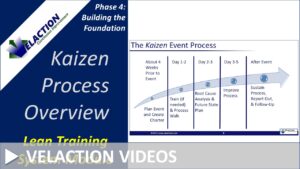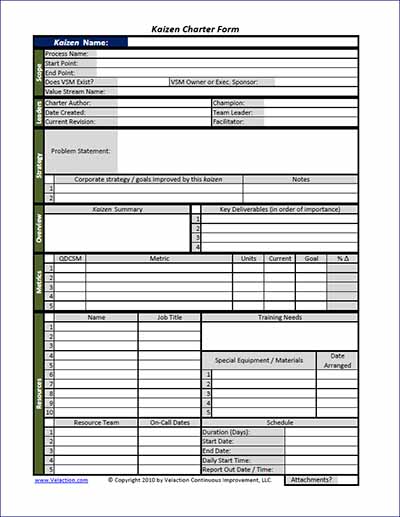Blitz, Kaizen
A blitz is an intensive project, typically a week long, with focused gains in mind. The term kaizen or kaizen event are sometimes used interchangeably with blitz. Kaizen, in a broader sense though, is any effort to make something better. It makes for a bit of confusion about whether you are talking about a structured event or just a general improvement effort.
The overall process for a blitz is something like this:
Pre-Work
- Identify opportunity.
- Create a charter.
- Form a team.
- Collect data, plan, and arrange resources.
Kaizen blitz week
- Day 1-Complete training (if needed).
- Day 2-Review current process and develop improvement plan.
- Day 3 and Day 4-Implement changes.
- Day 5-Wrap-up and do a report out on the changes.
Follow-up
- Complete follow-up action items.
- Complete training.
- Audit the process.
- Continue to improve.
>>Get a copy of a kaizen blitz planning checklist>>

Minute for minute, there is nothing more powerful in the continuous improvement world than a well-executed kaizen blitz. It is amazing how much can be accomplished in a short time by a dedicated team. I have seen whole lines redesigned, walls torn out to make room for better flow, machines designed and built, and a host of other tremendous accomplishments. I have heard incredulous gasps as people see the new layout. I have heard ovations as people presented their gains.
But blitzes, while effective, are also hard. There are frequently a lot of late nights. There is a lot of working outside comfort zones. There can be a lot of conflict as changes are made. But as people become more accustomed to kaizen blitzes, their responses change. People become more receptive to them, and even welcome them as the company gets a track record of success. Confrontation becomes collaboration. It never really gets easy, but as a company matures from a continuous improvement standpoint, more of the effort is spent on making improvements and less is spent on managing the kaizen blitz process and the emotional side of it.
There are some common pitfalls to be careful of when doing a kaizen blitz.
- Don’t bite off more than you can chew. Very little detracts from the kaizen blitz process as much as leaving a string of long follow-up lists in its wake. Properly managing the scope in the first place and watching for scope creep can prevent this.
- Don’t exclude people. You will lose support if the same people are always on kaizen That said, be strategic about including resistant people on a team. Include too many, and a negative attitude can propagate, derailing a blitz.
- Don’t report gains that you are hoping for. Credibility is key. Make sure any gains you report are real. Only report projected gains if you are certain they can be achieved and be sure to report them as projected.
- Make sure people are not getting surprised by the changes you are making.
- Make blitzes routine. Decide if kaizen blitzes are going to be routine and recurring, or a major event each time. If you are frequently doing them, try to limit the long hours and chaos that surrounds a big event. People will step up when needed, but you shouldn’t expect them to do it on a regular basis. You risk burning them out.
- Don’t forget to reward blitz teams. You are asking something special of them. Make sure you…
Extended Content for this Section is available at academy.Velaction.com
![]()
This term is accompanied by several of our forms & tools. You can purchase them at our online store. We also offer free versions of many forms.




0 Comments